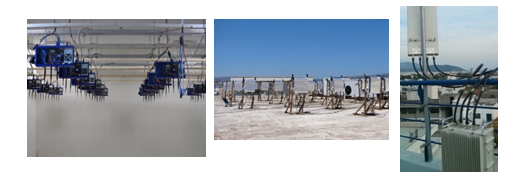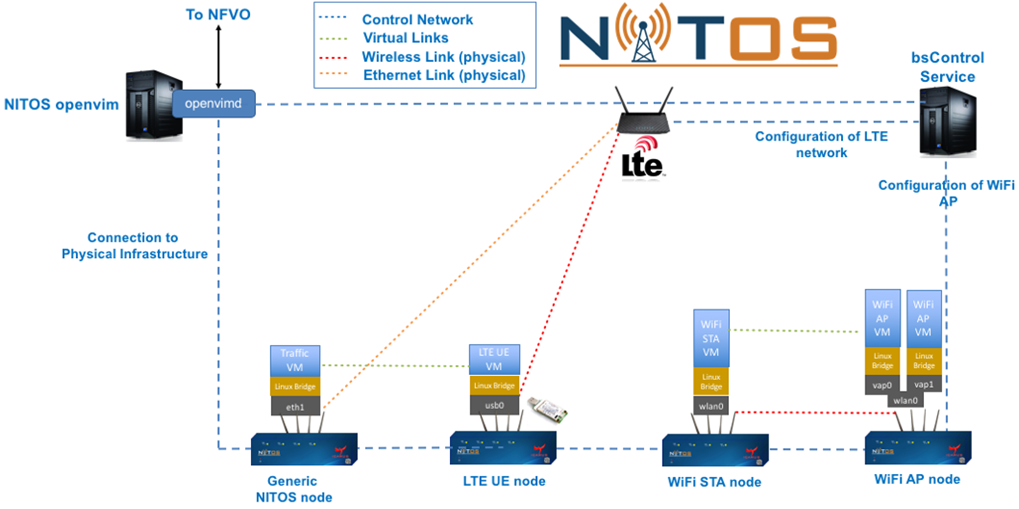5G Virtual Infrastructure provisioning over NITOS testbed
Virtual Infrastructure provisioning over NITOS testbed (5G-VINO) aspires to integrate the NITOS* testbed with the existing facilities of 5GINFIRE. This integration is not limited to the physical interconnection of the facility with the ones of 5GINFIRE but includes the provisioning of a kit of new NSDs and VNFs specific to the new technologies offered through NITOS. The wide experimentation environment created through the NITOS addition will render the experimental evaluation of multiple use case scenarios feasible, driven by the required use cases for 5G. These experiments include use cases that are currently high priority for 5G, such as MEC, with services being deployed at the edge of the wireless network and reducing the latency to access the content, experiments measuring the impact of different transport solutions for the functional splitting of the base station stack, end-to-end system virtualization and orchestration, as well as SFC, for the construction of chains of actions out of smaller elements that enable flexible service provisioning depending on the end-users’ requests (for example chaining MME, HSS, S/P-GW services to form a virtual EPC [9] per infrastructure tenant).
The proposed integration will be developed around three strands:
1) Physical Interconnection of the facilities,
2) MANO integration of the offered experimentation capabilities, and
3) adding new services to the 5GINFIRE portfolio of offered services.
In the following subsections we analyse the testbed architecture and experimental components that are available in NITOS, and will be integrated in the 5GINFIRE project.
*“Network Implementation Testbed Laboratory (NITOS),” May-2018. [Online]. Available: https://nitlab.inf.uth.gr/NITlab/nitos . [Accessed: 04-Jun-2018].
NITOS testbed equipment
5G-VINO builds upon the existing efforts of University of Thessaly (UTH) in deploying and operating cutting edge infrastructure. UTH is operating since 2007 the Network Implementation Testbed using Open Source platforms (NITOS), which has evolved over the years to a compact solution for evaluating bleeding-edge ideas on the forefront of networking related research. The NITOS testbed is one of the large single-site open experimental facilities in Europe, allowing users from around the globe to take advantage of highly programmable equipment (see Figure 18). The testbed is an integral part of larger federations of resources, such as OneLab [10] and Fed4FIRE [11], enabling experiments with more heterogeneous resources. NITOS has an established user base of over 4000 users in the past years, with over 20 researchers using the infrastructure in a daily basis. In short, the current offering of the testbed is the following:
- Over 100 nodes equipped with IEEE 802.11 a/b/g/e/n/ac compatible equipment and using open source drivers. The nodes are compatible also with the IEEE 802.11s [12] protocol for the creation of wireless mesh networks. The nodes feature multiple wireless interfaces, and are high-end computers, with quad-core Intel Core i5 and Core i7 processing capabilities, 4/8 GBs of RAM and SSD disks.
- Commercial off-the-shelf (COTS) LTE testbed, consisting of a highly programmable LTE macrocell, multiple femtocells, an experimenter configurable EPC network and multiple User Equipment (UE), such as USB dongles and Android Smartphones [13] .
- Open Source LTE equipment, running over commodity Software Defined Radio (SDR) equipment, by the adoption of the OpenAirInterface (www.openairinterface.org) platform [14]. The platform is allowing multiple configurations for creating highly customizable beyond 4G networks.
- COTS WiMAX testbed, based on a highly programmable WiMAX base station in standalone mode (no ASN-GW component), along with several open source WiMAX clients.
- A SDR 5G testbed, consisting of 10 USRPs N210, 12 USRPs B210, 4 USRPs X310 and 4 ExMIMO2 FPGA boards. MAC and PHY algorithms can be executed over the SDR platforms, with very high accuracy.
- A millimeter wave testbed, operating in the V-band (60GHz), based on six nodes [15] . The platforms support high data-rate point-to-point setups, with beam steering capabilities of up to 90 degrees with a step of 7.5 degrees.
- The nodes are interconnected with each other via 5 OpenFlow [16] hardware switches, sliced using the FlowVisor [17]
- A Cloud Computing testbed, consisting of 96 Cores, 286 GB RAM and 10 TBs of hardware storage. For the provisioning of the cloud, OpenStack is used.
- Multiple WSN clusters, supporting the IEEE 802.15.4, 802.11 and LoRaWAN protocols [18] , gathering measurements such as temperature, luminosity, air quality, radiation emission, etc.
The equipment is distributed across three different testbed locations in the city of Volos and can be combined with each other for creating a very rich experimentation environment. The nodes are running any major UNIX based distributions.

NITOS testbed deployments; indoor/outdoor testbeds and COTS LTE macro-cell
For the integration with the 5GINFIRE orchestrator, NITOS will provide an interface to the VIM that is currently being used by the testbed. The adopted VIM by NITOS is OpenVIM [19], extended to support the following configurations:
- Each testbed node is a compute node for OpenVIM’s datacenter configuration.
- Each node can use one of the two physical Ethernet interfaces for its control (mgmt interface) by OpenVIM.
- New network configurations to support connection to the physical network interfaces of either LTE or WiFi technology.
- Upon reception of a VNF configuration requiring the setup of an LTE network or a WiFi AP, calls are made to the REST interface of the testbed’s BSControl service [13] , that is in charge of configuring either the LTE infrastructure network (base stations and Core Network) or the WiFi APs.
- Virtual Deployment Units (VDUs) are able to be provisioned regarding the LTE UEs with guarantees on the maximum achievable aggregate bandwidth on UL and DL per each client, WiFi Access Point VDUs per each physical virtual access point provisioned through the Virtual Access Point functionality of the drivers used in the testbed, and WiFi station VDUs.
A high level functional representation of this interaction across the different testbed components is shown in the figure below. It is worth to mention, that currently OpenSourceMANO (OSM) is being used in NITOS for the orchestration of the testbed’s resources. The extensions were developed using the OSM Release TWO, whereas all the functionality has been moved currently to OSM Release THREE. These extensions are also propagated to the OSM User Interface, where the end-user can list more network configurations, depending on the type of the network used.

High Level interaction between the different components in NITOS through OpenVIM

